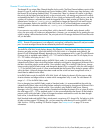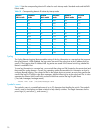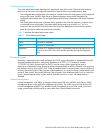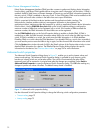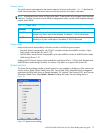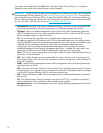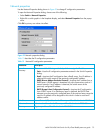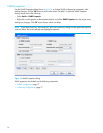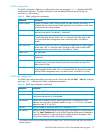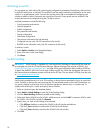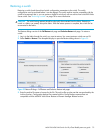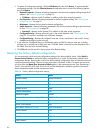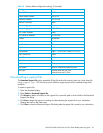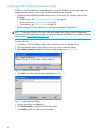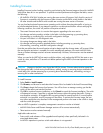
McDATA® 4Gb SAN Switch for HP p-Class BladeSystem user guide 77
SNMP configuration
The SNMP configuration defines how authentication traps are managed. Table 14 describes the SNMP
configuration parameters. The illegal characters for the user-defined fields are the pound sign (#),
semi-colon (;), and comma (,).
SNMP trap configuration
The SNMP trap configuration defines how traps are set. Choose from the tabs Trap1 – Trap 5 to configure
each trap. Table 15 describes the SNMP configuration parameters.
Table 14 SNMP configuration parameters
Parameter Description
SNMP Enabled Enables or disables SNMP communication with other switches in the fabric. If
disabled, the user cannot use an SNMP application at a workstation to talk to the
switch that has this setting disabled.
Contact Specifies the name (up to 64 characters) of the person who is to be contacted to
respond to trap events. The default is “undefined”.
Read Community Read community password (up to 32 characters) that authorizes an SNMP agent
to read information from the switch. This is a write-only field. The value on the
switch and the SNMP management server must be the same. The default is
“public”.
Trap Community Trap community password (up to 32 characters) that authorizes an SNMP agent to
receive traps. This is a write-only field. The value on the switch and the SNMP
management server must be the same. The default is “public”.
SNMP Proxy Not applicable.
Location Specifies the name (up to 64 characters) for the switch location. The default is
“undefined”.
Authentication Trap Enables or disables the reporting of SNMP authentication failures. If enabled, a
notification trap is sent when incorrect community string values are used. The
default value is False.
Write Community Write community password (up to 32 characters) that authorizes an SNMP client to
write information to the switch. This is a write-only field. The value on the switch
and the SNMP management server must be the same. The default is “private”.
Table 15 SNMP trap configuration parameters
Parameter Description
Trap Version Specifies the SNMP version (1 or 2) with which to format traps.
Trap 1 Enabled Enables or disables the trap. If disabled, traps are not sent to trap monitoring stations
and the trap settings are not configurable.
Trap Address
1
1.Trap address (other than 0.0.0.0) and trap port combinations must be unique. For example, if trap 1 and trap 2 have the
same address, then they must have different port values. Similarly, if trap 1 and 2 have the same port value, they must have
different addresses.
Specifies the IP address to which SNMP traps are sent. A maximum of 5 trap
addresses are supported. The default address for trap 1 is 10.0.0.254. The default
address for traps 2–5 is 0.0.0.0.
Trap Port
1
The port number on which the trap is sent. The default is 162.
Trap Severity Specifies a severity level to assign to the trap. Open the drop-down list and choose a
level. The Trap 1 Enabled option on the SNMP Properties dialog must be enabled to
access this drop-down list. Trap severity levels include Unknown, Emergency, Alert,
Critical, Error, Warning, Notify, Info, Debug, and Mark



